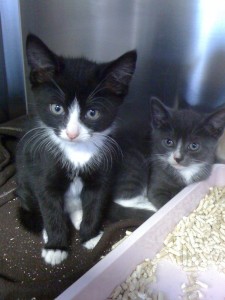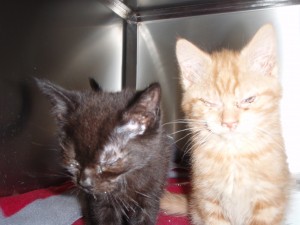Cat vaccinations
Vaccinating your cat is very important, it protects them against common and deadly diseases, some of which have no cure. The injections are given from 9 weeks old and most vets give annual boosters. This page discusses the vaccine protocols, why they are important, and the diseases we can protect our cats against.
- Primary boosters
- Annual boosters
- What we vaccinate against;
- Cat Flu (Feline Herpes Virus & Feline Calicivirus)
- Feline Leukaemia (FeLV)
Primary boosters
- For kittens, vaccinations start at 9 weeks old with a second injection 3-4 weeks later. Current WSAVA guidelines also advise a final dose at 14-16 weeks but not many vets carry this out routinely.
- In adult cats the primary booster course can be started at any time, again there are 2 injections 3-4 weeks apart.
- Two injections are given as the second vaccination adds to the protection from the first and together they push the levels as high as possible. It is a bit like adding 2 and 2 and getting 5!
- When kittens suckle the colostrum from their mother, she passes some protection to them from her own immune system against these viruses, this is called ‘Maternally Derived Antibodies’ or MDA
- It is important to wait until 9 weeks of age before vaccinating kittens as before this the levels of MDA will still be high, and may destroy the vaccination before it has chance to work.
- About 3 weeks after the second vaccination the levels of protection in the blood will be high enough to protect the kitten from the viruses.
- However, we would advise to keep your kitten in until they are about 6 months old. At this age they should have been neutered, so there is no chance of pregnancy and less of them fighting, they will be big enough to hold their own against the neighbourhood cats, and a lot of cats these days are micro-chipped while they are under the anaesthetic for neutering.
- There are 3 main diseases that cats are vaccinated against in the primary booster courses, Cat Flu, Feline Enteritis and Feline Leukaemia, these are discussed in more detail at the bottom of this page.
- With some makes of vaccines the Feline Leukaemia is an optional extra. We would always recommend giving your cat the maximum protection, to learn more about Feline Leukaemia, click here
- If you don’t have the Feline Leukaemia, but then change your mind, it can be easily started at any time, or with the annual boosters, it just needs two injections to get it started, at a 3 week interval like the others.

Kitten are vaccinated at 9 weeks and 12-13 weeks old.
Annual boosters
- The current WSAVA recommendations are that adult cats should be vaccinated within 12 months of their initial injection course and then the majority will only need a booster every 3 years.
- However, most vets still inject their patents annually,
- The currentIt is important to have your cat vaccinated every year, as the protection from the vaccines will wane over time.
- All the diseases that we vaccinate cats against are included in the vaccines every year. There is evidence that protection against some disease lasts longer than this, but not enough research has yet been carried out to be sure, and most vets still advise annual vaccination.
- Do not worry if you have run slightly over the due date for the vaccination booster, most vets agree you can go up to 3 months after the date the booster was due before you have to restart the course.
- If you do go 3 months over the due date of the vaccination, it is best to restart the course. You can just chose to have a single booster injection, but full protection cannot be guarenteed.
- Cats who go to catteries or cat shows will be required to have up to date vaccinations.
- It is possible to vaccinate cats against feline kennel cough, more properly called Bordatella Bronchisepta. Like the dog vaccinations it is given as drops into the nose. Some catteries will insist on it, but not all.
- Side effects from vaccinations, either at the primary course or the annual boosters are very rare. The risk of any adverse effects is far outweighed by the protection given against some very nasty diseases.
- One side effect that has been gaining notoriety is the ‘Vaccine Site Sarcoma’. These are more common in the USA than the UK. Some vaccines have been implicated in the formation of tumours at the site of the vaccination. However, it should be stressed, these are very rare. I f you have any concerns, you should talk to your vet.
- Annual boosters are a good opportunity for you to have a chat with your vet, find out how your cat is and discuss any concerns you may have.
- There are homeopathic vaccinations available for animals. We do not recommend you have these, there is no evidence at all that they provide any protection at all against the feline diseases.
What we vaccinate against
Cat flu ( Feline Calicivirus and Feline herpes virus)
- Cat flu is a very common and nasty viral disease that can cause severe flu like symptoms, including nasal discharge, sneezing and coughing, mouth and eye ulcers, lethargy and anorexia.
- It is caused by 2 main viruses, Feline Calcivirus (FCV), and Feline Herpesvirus (FHV).
- The viruses are spread by direct contact between cats, and are found in the discharge from the eyes and nose, they do not survive long in the environment.
- Once a cat has become infected with either FCV or FHV, it is possible for them to become carriers of the viruses, which means they can infect other cats, even if they have no symptoms of cat flu.
- Vaccination against FCV and FHV does not prevent cats becoming infected, but it does prevent the disease from becoming severe.
- A nasty bout of cat flu, especially in young animals, can cause permanant damage to the eyes, resulting in scarred corneas, or more commonly to the nose. The virus can damage the delicate internal nasal structures and these cats can have permenantly runny noses and snuffly breathing.
- There is no specific treatment for cat flu, cats have to be nursed though the illness. This can include antibiotics, drips, decongestants, hand feeding and intensive nursing.
- FCV and FHV are included in the annual boosters your vet will give your cat.

These kittens are suffering from cat flu, which would have probably been prevented if their mother had been properly vaccinated.
Feline Leukaemia (FeLV)
- Feline leukaemia is not an especially common disease, it is found in about 2% of the healthy cat population, and about 20% of the sick cat population. However, it is a very serious disease.
- Feline Leukaemia can cause a range of problems, but the most important one is it destroys the cat’s immune system, leaving them vunerable to picking up other illnesses.
- It can also cause cancers to form (lymphomas), anaemia ( low red blood cell levels), infertility and neurological problems (loss of balance, behavioural changes)
- It is not an easy disease to catch and cats normally have to have close, sustained contact with an infected animal to pick it up. This can be things like sharing food bowls, mutual grooming, and kittens will become infected if the queen is.
- Cats which are diagnosed with Feline Leukaemia have a very poor prognosis for long term survival and generally only live 3-4 years post diagnosis. However, this can be even less if they are sick at the time of diagnosis.
- Diagnosis is relatively easy, there are simple, in-house blood tests that can be run at your vets surgery, or the blood can be sent away for testing.
- Once a cat it infected with feline leukaemia there is very little treatment available. There are anti-viral drugs that can be given, but they are not particularly effective. Treatment is usually aimed at treating any infections the cat may have picked up, but sick cats are often euthanased.
- FeLV infected cats, if they are healthy, can be kept. They need to be indoor cats and have no contact with other cats so they cannot pass the virus on.
- Vaccines are available against FeLV. However, they are not always included as standard, but your vet will discuss this with you.
- Feline Leukaemia vaccines have been implicated in the development of ‘Vaccine Site Sarcomas’, tumours which can occur at the site of the vaccination. However, these are very rare and the benefits of vaccination definately outweigh the risks.
Feline Enteritis
- This disease is also known as ‘Feline parvovirus’ as it is very similar to ‘canine parvovirus’.
- It is a highly infectious virus that spreads quickly between cats and survives well in the environment, which means all unvaccinated cats are at risk from picking it up.
- Clinical signs in adult cats are diarrhoea, vomiting, anorexia and dehydration, it also causes a drop in the number of white blood cells in the body so these cats are vunerable to other infections.
- The disease is most dangerous in kittens where is can cause death, development abnormalities, blindness and ‘cerebellar hypoplasia’
- Cerebellar Hypoplasia is a condition which affects the cerebellum, the part of the brain involved in balance. Affected kittens are ‘wobbly walkers’, they find it difficult to balance, and often fall over. They generally cope very well with life, and the prognosis is good.
- Feline Enteritis is included in the annual vaccinations cats are given, and is now an unusual disease thanks to vaccination.
This cat has Cerebellar Hypoplasia caused by a Feline Enteritis infection which she most likely caught in the womb. Her balance is poor and she is very wobbly but otherwise she is fine!
Please note, this is an advice only website, if your have any queries or concerns regarding your pet, you should contact your veterinary surgeon.